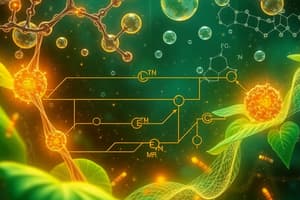Podcast
Questions and Answers
What are the three important aromatic amino acids primarily produced in plants through the shikimate pathway?
What are the three important aromatic amino acids primarily produced in plants through the shikimate pathway?
Tryptophan, tyrosine, and phenylalanine
Which aromatic amino acid is necessary for the synthesis of heme, thyroid hormones, neurotransmitters, and melanin?
Which aromatic amino acid is necessary for the synthesis of heme, thyroid hormones, neurotransmitters, and melanin?
Phenylalanine
What is tryptophan a precursor of?
What is tryptophan a precursor of?
Serotonin
Name two important neurotransmitters synthesized using tyrosine.
Name two important neurotransmitters synthesized using tyrosine.
What is a key industrial application of the shikimic acid pathway involving the production of antimalarial drugs?
What is a key industrial application of the shikimic acid pathway involving the production of antimalarial drugs?
How is artemisinic acid, an intermediate in the synthesis of antimalarial drug artesunate, produced industrially?
How is artemisinic acid, an intermediate in the synthesis of antimalarial drug artesunate, produced industrially?
What is the main role of the shikimic acid pathway in plant primary metabolism?
What is the main role of the shikimic acid pathway in plant primary metabolism?
What are some biologically active compounds that can be synthesized using the shikimic acid pathway?
What are some biologically active compounds that can be synthesized using the shikimic acid pathway?
How does the shikimic acid pathway start?
How does the shikimic acid pathway start?
What is the final product of the shikimic acid pathway before conversion to shikimic acid?
What is the final product of the shikimic acid pathway before conversion to shikimic acid?
What enzymatic reaction converts shikimate 3-phosphate into free shikimate?
What enzymatic reaction converts shikimate 3-phosphate into free shikimate?
How is shikimic acid eventually formed in the shikimic acid pathway?
How is shikimic acid eventually formed in the shikimic acid pathway?
Flashcards are hidden until you start studying
Study Notes
Shikimic Acid Pathway Overview
The shikimic acid pathway is a critical metabolic route involved in the production of various aromatic compounds, including many essential amino acids found in living organisms. This pathway plays a crucial role in plant primary metabolism due to its involvement in producing aromatic amino acids such as tryptophan, tyrosine, and phenylalanine. It also serves as a precursor for the synthesis of other biologically active compounds like flavonoids, lignin, quinate derivatives, and certain antibiotics. In microorganisms, the pathway is more diverse and can lead to the production of numerous compounds with significant industrial applications, including drugs such as antimalarials and antivirals. Additionally, it has been exploited by chemists and synthetic organic chemists for the manufacture of valuable chemicals.
Biosynthesis Mechanism
The shikimic acid pathway begins with the condensation of phosphoenolpyruvate (PEP) and erythrose-4-phosphate (E4P), which results in the formation of 3-deoxy-D-arabino-heptulosonic-7-phosphate (DAHP). After several enzyme-catalyzed reactions involving DAHP, chorismate synthase, prephenate dehydratase, and prephenate ammonia lyase, the final product—shikimate 3-phosphate—is produced. This compound is subsequently decarboxylated by shikimate kinase to yield free shikimate, which is eventually converted into shikimic acid through further catalytic steps.
Aromatic Amino Acids Synthesis
In plants, the shikimate pathway primarily contributes to the production of three important aromatic amino acids: tryptophan, tyrosine, and phenylalanine. These amino acids serve as building blocks for proteins and are required for normal growth and development. For instance, phenylalanine is necessary for the synthesis of heme, thyroid hormones, neurotransmitters, and melanin, while tryptophan is a precursor of serotonin. Tyrosine, on the other hand, is vital for the synthesis of catechols, dopamine, norepinephrine, epinephrine, and thyroxine.
Industrial Applications
Beyond its biological significance, the shikimic acid pathway holds great potential for industrial applications. One example is the production of antimalarial drugs from the bark of the cinchona tree, which contain high levels of quinines derived from the pathway. Another application involves using genetically engineered Escherichia coli bacteria to produce large quantities of artemisinic acid, a key intermediate in the synthesis of antimalarial drug artesunate. Furthermore, there is ongoing work exploring the possibility of engineering yeast strains capable of generating pharmaceuticals via this pathway.
Conclusion
The shikimic acid pathway represents a fundamental aspect of cellular life, playing a central role in the biosynthesis of essential amino acids and other aromatic molecules. Its versatile nature allows for the production of a wide range of products, spanning from natural compounds to industrially relevant materials. As our understanding continues to grow, so too does the potential for manipulating this pathway to address challenges in agriculture, medicine, and industry alike.
Studying That Suits You
Use AI to generate personalized quizzes and flashcards to suit your learning preferences.




